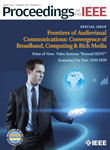Journal
Please choose volume & issue:
-
Protecting the Mixed-Signal Domain: Secure ADCs for Internet of Things Devices
Keywords:Internet of ThingsLogicStandardsCircuitsSwitchesPower demandEavesdroppingEncryptionAnalog-digital conversionNeural networksSide-channel attacksSecurityTrusted computingData privacyComputational efficiencyInternet Of ThingsAnalog-to-digital ConverterData IntegrationInternet Of Things DevicesAnalog SignalNeural NetworkLong Short-term MemoryRecurrent Neural NetworkInput VoltageRandom PhaseExternal SupplyLong Short-term Memory NetworkSide-channelSound ProcessorTop PlateNatural Language Processing TasksThreat ModelCapacitor ChargingDigital OutputSource LeakagePhysical Unclonable FunctionsArea OverheadRandom BitsPseudo-random Number GeneratorAttack MethodsTransformerMultilayer PerceptronNonlinear FunctionPower ConsumptionAnalog-to-digital converters (ADCs)Internet of Things (IoT)neural networksside-channel securityAbstracts:Analog-to-digital converters (ADCs) are a standard building block of most Internet of Things (IoT) devices, used to convert between analog signals of the physical world and digital values for efficient storage and computation. While decades of research have explored methods to optimize the traditional power, performance, and area parameters of these circuits, a new requirement has emerged in the last five years for ADCs—security. Due to the deployment of these devices at the edge outside of a trusted computing base, there is a potential for various eavesdropping and tampering attacks. This can have a severe impact on the privacy and integrity of sensor data, which cannot be corrected for through the secure design of other blocks that follow the front end. In this article, we explore the recent work in ADC security and analyze what has been accomplished as well as what remains to be done for the successful deployment of secure ADCs in commercial systems.
-
Deep Reinforcement Learning for Distribution System Operations: A Tutorial and Survey
Keywords:OptimizationTutorialsDeep reinforcement learningUncertaintyReviewsSystems operationSurveysMarkov decision processesDistributed power generationPower gridsPower distribution planningComplex networksOperating SystemDistribution SystemPower DistributionDeep Reinforcement LearningMarkov Decision ProcessPower Distribution SystemDistribution System OperatorGrid ServicesProblem In Distribution SystemsOptimization ProblemPower SystemControl ProblemDistribution NetworkMicrogridDevice ModelUtility GridDistributed Energy ResourcesDeep Reinforcement Learning AlgorithmTime StepLearning EnvironmentDeep Reinforcement Learning AgentState SpaceReward FunctionOptimal Power FlowOptimal PolicyCommon GridOptimal ControlDiscrete ActionBus VoltageDeep Reinforcement Learning MethodDeep reinforcement learning (DRL)grid servicesMarkov decision process (MDP)optimizationpower distribution systemsAbstracts:The rapid evolution of modern electric power distribution systems into complex networks of interconnected active devices, distributed generation (DG), and storage poses increasing difficulties for system operators. The large-scale integration of distributed energy resources (DERs) and the rapid exchange of measurement data via communication networks present major opportunities for advancing grid operations but also introduce greater uncertainty, higher data dimensionality, more complex network and device models, and challenging control and optimization problems. Deep reinforcement learning (DRL) algorithms are promising in addressing these challenges. However, they have not been effectively adapted for power systems applications, requiring extensive customization for implementation and evaluation. This has resulted in reproducibility challenges and a steep learning curve for researchers new to applying DRL algorithms to the power systems domain. To bridge these gaps, this tutorial aims to serve as a valuable resource for researchers interested in exploring learning-based algorithms to operate active power distribution networks. Specifically, this work presents a generalized process for translating sequential decision-making problems in power distribution systems into Markov decision process (MDP) formulations, illustrated through concrete grid service examples. Additionally, we introduce a simple environment design strategy to develop and evaluate example DRL algorithms for distribution system applications, complete with an included code repository to guide users through environment construction.
-
Deep-Learning-Empowered Super Resolution: A Comprehensive Survey and Future Prospects
Keywords:SurveysDegradationSuperresolutionMeasurementImage reconstructionTransformersVideosGenerative adversarial networksDistortionConvolutional neural networksDiffusion modelsGenerative AISuperresolutionComputer visionLight fieldsDeep learningSuper-resolutionComputer VisionLight FieldSingle Image Super-resolutionConvolutional Neural NetworkHigh-resolution ImagesConvolutional LayersGenerative Adversarial NetworksNatural ImagesResidual BlockPeak Signal-to-noise RatioLow-resolution ImagesMaximum A PosterioriLong-range DependenciesStereo ImagesMotion CompensationNeural Architecture SearchStructural Similarity Index MeasureSuper-resolution NetworkFréchet Inception DistanceSuper-resolution TaskSuper-resolution ModelBlur KernelAngular InformationAttention MechanismDisparity MapSuper-resolution PerformanceDiffusion ModelTemporal ConsistencySpatial DimensionsConvolutional neural network (CNN)diffusion modelgenerative adversarial network (GAN)super resolution (SR)TransformerAbstracts:Super resolution (SR) has garnered significant attention within the computer vision community, driven by advances in deep learning (DL) techniques and the growing demand for high-quality visual applications. With the expansion of this field, numerous surveys have emerged. Most existing surveys focus on specific domains, lacking a comprehensive overview of this field. Here, we present an in-depth review of diverse SR methods, encompassing single-image SR (SISR), video SR (VSR), stereo SR (SSR), and light field SR (LFSR). We extensively cover over 150 SISR methods, nearly 70 VSR approaches, and approximately 30 techniques for SSR and LFSR. We analyze methodologies, datasets, evaluation protocols, empirical results, and complexity. In addition, we conducted a taxonomy based on each backbone structure according to the diverse purposes. We also explore valuable yet understudied open issues in the field. We believe that this work will serve as a valuable resource and offer guidance to researchers in this domain. To facilitate access to related work, we created a dedicated repository available at https://github.com/AVC2-UESTC/Holistic-Super-Resolution-Review
Hot Journals
- Risk Breakdown Matrix for Risk-Based Inspection of Transportation Infrastructure Projects
- Social Control in Outsourced Architectural and Engineering Design Consulting Projects: Behavioral Consequences and Motivational Mechanism
- 2022 Best Paper Award
- Hold-Ups and Failures in Negotiated Order: Unearthing the Nuances of Rework Causation in Construction
- Prevalence and Risk Factors for Poor Mental Health and Suicidal Ideation in the Nigerian Construction Industry
- CFRP–Cable-Stayed Bridge Hybrid with Partial Suspension and a Span Exceeding 3,000 m: Concept, Optimization, and Construction
- Impact of Wind Load Characteristics on Computed Bridge Stay-Cable Forces Used for Bridge Health Monitoring
- Weak-End and Frequency Detection of Elastically Supported Bridges by Contact Residual Response of Two-Axle Test Vehicle in a Round Trip
- Development of Performance-Based Fragility Curves of Coastal Bridges Subjected to Extreme Wave-Induced Loads
- An Analytical Model to Evaluate Short- and Long-Term Performances of Post-Tensioned Concrete Box-Girder Bridges Rehabilitated by an Ultrahigh-Performance Concrete Overlay
- Three-Dimensional Velocity Distribution in Straight Smooth Channels Modeled by Modified Log-Law
- Experimental Investigation on Flow Past Two and Three Side-by-Side Inclined Cylinders
- An Experimental Investigation of Rotor–Box Aerodynamic Interaction 1
- Modeling Gas–Liquid Flow Between Rotating and Nonrotating Annular Disks
- Entry Length Requirements for Two- and Three-Dimensional Laminar Couette–Poiseuille Flows
Advanced Materials (3,745)
- Structured Perovskite Light Absorbers for Efficient and Stable Photovoltaics
- Strategies for High‐Performance Solid‐State Triplet–Triplet‐Annihilation‐Based Photon Upconversion
- Atomic Engineering Catalyzed MnO2 Electrolysis Kinetics for a Hybrid Aqueous Battery with High Power and Energy Density
- Crystal Adaptronics: Global Performance Indices for Dynamic Crystals as Organic Thermal Actuators (Adv. Mater. 20/2020)
- Enlightening Materials with Photoswitches
Acta Astronautica (1,768)
- Mixed-integer trajectory optimization with no-fly zone constraints for a hypersonic vehicle
- Adaptive control design for active Pogo suppression of large strap-on liquid launch vehicles
- Machine learning based approach for modeling and forecasting of GPS–TEC during diverse solar phase periods
- Effect of two-dimensional micro-cavity surface on hypersonic boundary layer
- Investigation on burning behaviors of aluminum agglomerates in solid rocket motor with detailed combustion model








 User Center
User Center My Training Class
My Training Class Feedback
Feedback





